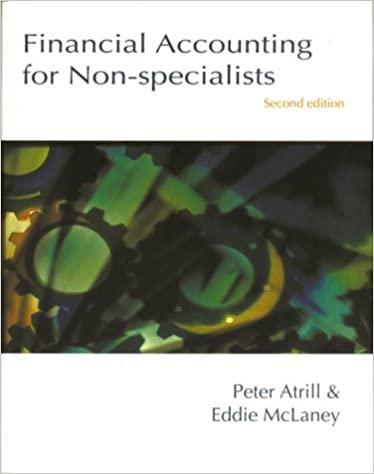Question
Gigabyte, Inc. manufactures three products for the computer industry Gismos (product G): annual sales, 8,000 units Thingamajigs (product T): annual sales, 15,000 units Whatchamacallits (product
Gigabyte, Inc. manufactures three products for the computer industry
Gismos (product G): annual sales, 8,000 units
Thingamajigs (product T): annual sales, 15,000 units
Whatchamacallits (product W): annual sales, 4,000 units
The company uses a traditional, volume-based product-costing system with manufacturing over-head applied on the basis of direct-labor dollars. The product costs have been computed as follows:
Product G Product T Product W
Raw material ....$ 35.00 $52.50 $17.50
Direct labor ............ 16.00 (.8 hr. at $20) 12.00 (.6 hr. at $20) 8.00 (.4 hr. at $20)
Manufacturing overhead* 140.00 105.00 70.00
Total product cost $191.00 $169.50 $95.50
*Calculation of predetermined overhead rate:
Manufacturing overhead budget: Machine setup ......................................................$ 5,250 Machinery ......................................................................................................................1,225,000 Inspection ..........................................................................................................................525,000
Material handling ..............................................................................................................875,000 Engineering ........................................................................................................................344,750
Total .............................................................................................................................$2,975,000
Direct-labor budget (based on budgeted annual sales):
Product G: 8,000 $16.00=$128,000
Product T: 15,000 $12.00=180,000
Product W: 4,000 $8.00= 32,000
Total $340,000
Predetermined overhead rate = Budgeted overhead/ Budgeted direct labor = 875%
Gigabytes pricing method has been to set a target price equal to 150 percent of full product cost. However, only the thingamajigs have been selling at their target price. The target and actual current prices for all three products are the following:
Product G Product T Product W
Product cost ........................$ 191.00 $169.50 $95.50
Target price ............................286.50 254.25 143.25
Actual current selling price ....213.00 254.25 200.00
Gigabyte has been forced to lower the price of gismos in order to get orders. In contrast, Gigabyte has raised the price of whatchamacallits several times, but there has been no apparent loss of sales. Gigabyte, Inc. has been under increasing pressure to reduce the price even further on gismos. In contrast, Gigabytes competitors do not seem to be interested in the market for whatchamacallits. Gigabyte apparently has this market to itself.
Required:
1. Is product G the companys least profitable product?
2. Is product W a profitable product for Gigabyte, Inc.?
.3. Comment on the reactions of Gigabytes competitors to the firms pricing strategy. What dangers does Gigabyte, Inc. face?
4. Gigabytes controller, Nan OSecond, recently attended a conference at which activity-based costing systems were discussed. She became convinced that such a system would help Gigabytes management to understand its product costs better. She got top managements approval to design an activity-based costing system, and an ABC project team was formed. In stage one of the ABC project, each of the overhead items listed in the overhead budget was placed into its own activity cost pool. Then a cost driver was identified for each activity cost pool. Finally, the ABC project team compiled data showing the percentage of each cost driver that was consumed by each of Gigabytes product lines. These data are summarized as follows:
Activity Cost Pool Cost Driver Product G Product T Product W
Machine setup Number of setups 20% 30% 50%
Machinery Machine hours 25% 50% 25%
Inspection Number of inspections 15% 45% 40%
Material handling Raw-material costs 25% 69% 6%
Engineering Number of change orders 35% 10% 55%
Show how the controller determined the percentages given above for raw-material costs. (Round to the nearest whole percent.)
5. Develop product costs for the three products on the basis of an activity-based costing system. (Round to the nearest cent.)
6. Calculate a target price for each product, using Gigabytes pricing formula. Compare the new tar-get prices with the current actual selling prices and previously reported product costs.
7. Build a spreadsheet: Construct an Excel spreadsheet to solve requirements (5) and (6) above. Show how the solution will change if the inspection activity was divided among the three products in the following manner: product G, 20%; product T, 40%, and product W, 40%.
Step by Step Solution
There are 3 Steps involved in it
Step: 1

Get Instant Access to Expert-Tailored Solutions
See step-by-step solutions with expert insights and AI powered tools for academic success
Step: 2

Step: 3

Ace Your Homework with AI
Get the answers you need in no time with our AI-driven, step-by-step assistance
Get Started


